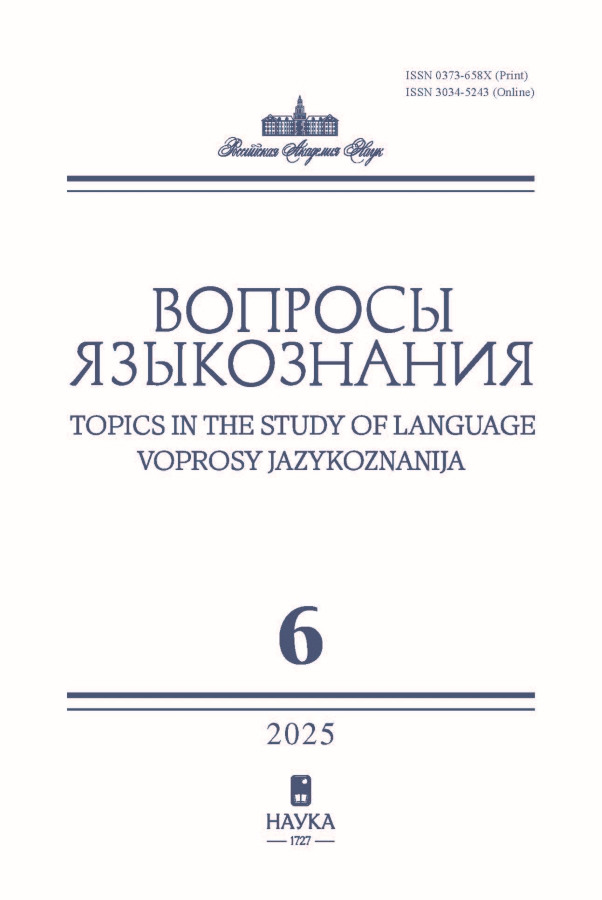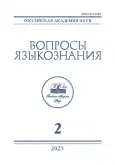The structure of the semantic domain of modality in Russian: Modelling systemic relations between constructions (based on the Russian Constructicon)
- Authors: Mordashova D.D.1,2
-
Affiliations:
- Institute of Linguistics, Russian Academy of Sciences
- Lomonosov Moscow State University
- Issue: No 2 (2023)
- Pages: 29-55
- Section: Articles
- URL: https://journals.rcsi.science/0373-658X/article/view/141133
- DOI: https://doi.org/10.31857/0373-658X.2023.2.29-55
- ID: 141133
Full Text
Abstract
Keywords
About the authors
Daria Dmitrievna Mordashova
Institute of Linguistics, Russian Academy of Sciences; Lomonosov Moscow State UniversityRussia, Moscow
References
- Бондарко (ред.) 1990 — Бондарко А. В. (ред.). Теория функциональной грамматики. Темпоральность. Модальность. Л.: Наука, 1990.
- Бонч-Осмоловская 2003 — Бонч-Осмоловская А. А. Конструкции с дативным субъектом в русском языке: опыт корпусного исследования. Дис. … канд. филол. наук. М.: МГУ, 2003.
- Булыгина, Шмелев 1993 — Булыгина Т. В., Шмелев А. Д. Гипотеза как мыслительный и речевой акт. Логический анализ языка: Ментальные действия. Арутюнова Н. Д., Рябцева Н. К. (отв. ред.). М.: Индрик, 1993, 78–82.
- Виноградов 1975 — Виноградов В. В. Избранные труды. Исследования по русской грамматике. М.: Наука, 1975.
- Добровольский, Зализняк 2020 — Добровольский Д. О., Зализняк Анна А. Русские конструкции с потенциально модальным значением по данным параллельных корпусов. Труды Института русского языка им. В. В. Виноградова, 2020, 3(25): 35–48.
- Добрушина 2006 — Добрушина Н. Р. Грамматические формы и конструкции со значением опасения и предостережения. Вопросы языкознания, 2006, 2: 28–67.
- Кобозева, Лауфер 1991 — Кобозева И. М., Лауфер Н. И. Семантика модальных предикатов долженствования. Логический анализ языка. Культурные концепты. Н. Д. Арутюнова (отв. ред.). М.: Наука, 1991, 169–174.
- Летучий 2008 — Летучий A. Б. Cравнительные конструкции, ирреалис и эвиденциальность. Lexikalische Evidenzialitäts-Marker in slavischen Sprachen. Wiemer B., Plungjan V. A. (Hrsg.). München: Sagner, 2008, 215–238.
- Летучий 2017 — Летучий А. Б. Сравнительные конструкции. Материалы к корпусной грамматике русского языка. Вып. II: Синтаксические конструкции и грамматические категории. Плунгян В. А., Стойнова Н. М. (отв. ред.). М.: ИРЯ РАН, 2017, 132–204.
- НКРЯ — Национальный корпус русского языка. https://ruscorpora.ru
- Падучева 2016 — Падучева Е. В. Модальность. Материалы для проекта корпусного описания русской грамматики. На правах рукописи. М., 2016. http://rusgram.ru/Модальность
- Петрова 2007 — Петрова М. А. Типы немодальных значений модальных предикатов (на материале славянских и германских языков). Дис. … канд. филол. наук. М.: Ин-т языкознания РАН, 2007.
- Плунгян 2008 — Плунгян В. А. О показателях чужой речи и недостоверности в русском языке: мол, якобы и другие. Lexikalische Evidenzialitäts-Marker in slavischen Sprachen. Wiemer B., Plungjan V. A. (Hrsg.). München: Sagner, 2008, 285–311.
- Плунгян 2011 — Плунгян В. А. Введение в грамматическую семантику: грамматические значения и грамматические системы языков мира. М.: РГГУ, 2011.
- Рахилина 2013 — Рахилина Е. В. Кондуктор, нажми на тормоза… Компьютерная лингвистика и интеллектуальные технологии: По материалам ежегодной Международной конференции «Диалог», 2013, 12(19): 665–673.
- Рахилина и др. 2021 — Рахилина Е. В., Бычкова П. А., Жукова С. Ю. Речевые акты как лингвистическая категория: дискурсивные формулы. Вопросы языкознания, 2021, 2: 7–27.
- Храковский 2007 — Храковский В. С. Эвиденциальность, эпистемическая модальность, (ад)миративность. Эвиденциальность в языках Европы и Азии. Сб. статей памяти Н. А. Козинцевой. Храковский В. С. (ред.). СПб.: Наука, 2007, 600–632.
- Эндресен и др. 2020 — Эндресен А. А., Жукова В. А., Мордашова Д. Д., Рахилина Е. В., Ляшевская О. Н. Русский конструктикон: новый лингвистический ресурс, его устройство и специфика. Компьютерная лингвистика и интеллектуальные технологии: По материалам ежегодной Международной конференции «Диалог», 2020, 19(26): 226–241.
- Яковлева 1988 — Яковлева Е. С. Согласование модусных характеристик в высказывании. Прагматика и проблемы интенсиональности. Арутюнова Н. Д. (отв. ред.). М.: Ин-т языкознания РАН, 1988, 278–302.
- Achard 1998 — Achard M. Representation of cognitive structures: Syntax and semantics of French sentential complements. Berlin: Mouton de Gruyter, 1998.
- Aikhenvald 2004 — Aikhenvald A. Yu. Evidentiality. Oxford: Oxford Univ. Press, 2004.
- Anderson 1986 — Anderson L. B. Evidentials, paths of change, and mental maps: Typologically regular asymmetries. Evidentiality: The linguistic coding of epistemology. Chafe W., Nichols J. (eds.). Norwood (NJ): Ablex Publishing, 1986, 273–312.
- Bast et al. 2021 — Bast R., Endresen А., Janda L. A., Lund M., Lyashevskaya O., Mordashova D., Nesset T., Rakhilina E., Tyers F. M., Zhukova V. The Russian Constructicon. An electronic database of the Russian grammatical constructions, 2021. https://constructicon.github.io/russian/
- Boogaart 2009 — Boogaart R. Semantics and pragmatics in construction grammar: The case of modal verbs. Contexts and constructions. Bergs A., Diewald G. (eds.). Amsterdam: John Benjamins, 2009, 213–241.
- Boogaart, Fortuin 2016 — Boogaart R., Fortuin E. Modality and mood in cognitive linguistics and construction grammars. The Oxford handbook of modality and mood. Nuyts J., van der Auwera J. (eds.). Oxford: Oxford Univ. Press, 2016, 514–534.
- Boye 2001 — Boye K. The force-dynamic core meaning of Danish modal verbs. Acta Linguistica Hafniensia, 2001, 33: 19–66.
- Boye 2005 — Boye K. Modality and the concept of force-dynamic potential. Modality: Studies in form and function. Klinge A., Müller H. H. (eds.). London: Equinox, 2005, 49–80.
- Boye 2016 — Boye K. The expression of epistemic modality. The Oxford handbook of modality and mood. Nuyts J., van der Auwera J. (eds.). Oxford: Oxford Univ. Press, 2016, 117–140.
- Bybee 1985 — Bybee J. L. Morphology: A study of the relation between meaning and form. Amsterdam: John Benjamins, 1985.
- Bybee et al. 1994 — Bybee J., Perkins R., Pagliuca W. The evolution of grammar: Tense, aspect and modality in the languages of the world. Chicago: Univ. of Chicago Press, 1994.
- Coates 1983 — Coates J. The semantics of the modal auxiliaries. London: Croom Helm, 1983.
- Croft 2001 — Croft W. Radical Construction Grammar. Syntactic theory in typological perspective. Oxford: Oxford Univ. Press, 2001.
- Diessel 2004 — Diessel H. The acquisition of complex sentences. Cambridge: Cambridge Univ. Press, 2004.
- Diewald 2006 — Diewald G. Context types in grammaticalization as constructions. Constructions, 2006, Special vol. 1: Constructions all over: Case studies and theoretical implications. Schönefeld D. (ed.). https://doi.org/10.24338/cons-443
- Ehrlemark et al. 2016 — Ehrlemark A., Johansson R., Lyngfelt B. Retrieving occurrences of grammatical constructions. Proc. of COLING 2016, the 26th International Conf. on Computational Linguistics: Technical papers. Matsumoto Y., Prasad R. (eds.). Osaka: The COLING 2016 Organizing Committee, 2016, 815–824.
- Endresen, Janda 2020 — Endresen A., Janda L. A. Taking Construction Grammar one step further: Families, clusters, and networks of evaluative constructions in Russian. Defining construction: Insights into the emergence and generation of linguistic representations (special issue of Frontiers in Psychology). Putnam M., Carlson M., Fábregas A., Wittenberg E. (eds.). Lausanne: Frontiers Media SA, 2020, 1–22.
- Endresen et al., to appear — Endresen A., Janda L. A., Zhukova V., Mordashova D., Rakhilina E. Turning a list into a network via family-based expansion of the Russian Constructicon. Constructing constructicons. Ziem A. et al. (eds.). To appear.
- Fillmore et al. 1988 — Fillmore C. J., Kay P., O’Connor M. C. Regularity and idiomaticity in grammatical constructions: The case of let alone. Language, 1988, 64(3): 501–538.
- Fillmore 2008 — Fillmore C. J. Border conflicts: FrameNet meets Construction Grammar. Proc. of the XIII EURALEX International Congress. Bernal E., DeCesaris J. (eds.). Barcelona: Universitat Pompeu Fabra, 2008, 49–68.
- Fillmore et al. 2012 — Fillmore C. J., Lee-Goldman R., Rhodes R. The FrameNet constructicon. Sign-Based Construction Grammar. Boas H. C., Sag I. A. (eds.). Stanford: CSLI Publications, 2012, 309–372.
- Fortuin 2005 — Fortuin E. From possibility to necessity: The semantic spectrum of the dative-infinitive construction in Russian. Modality in Slavonic languages: New perspectives. Hansen B., Karlik P. (eds.). München: Otto Sagner, 2005, 39–60.
- Goldberg 2006 — Goldberg A. Constructions at work. The nature of generalization in language. Oxford: Oxford Univ. Press, 2006.
- de Haan 2006 — de Haan F. Typological approaches to modality. The expression of modality. Frawley W. (ed.). Berlin: Mouton de Gruyter, 2006, 27–69.
- Hengeveld 1989 — Hengeveld K. Layers and operators in Functional Grammar. Journal of Linguistics, 1989, 25: 127–157.
- Hilpert 2014 — Hilpert M. Construction Grammar and its application to English. Edinburgh: Edinburgh Univ. Press, 2014.
- Hofmann 1976 — Hofmann T. R. Past tense replacement and the modal system. Syntax and semantics. Vol. 7: Notes from the linguistic underground. McCawley J. (ed.). New York: Academic Press, 1976, 85–100.
- Janda et al. 2018 — Janda L. A., Lyashevskaya O., Nesset T., Rakhilina E., Tyers F. M. A constructicon for Russian: Filling in the gaps. Constructicography: Constructicon development across languages. Lyngfelt B., Borin L., Ohara K., Torrent T. T. (eds.). Amsterdam: John Benjamins, 2018, 165–181.
- Janda et al. 2020 — Janda L. A., Endresen A., Zhukova V., Mordashova D., Rakhilina E. How to build a constructicon in five years: The Russian example. Squibs in Construction Grammar, Brisard F., Colleman T., De Wit A., Enghels R., Koutsoukos N., Mortelmans T., Sansiñena M. S. (eds.). Thematic issue of Belgian Journal of Linguistics, 2020, 34: 161–173.
- Janda et al., to appear — Janda L. A., Endresen A., Zhukova V., Mordashova D., Rakhilina E. From data to theory: An emergent classification based on the large-scale Russian constructicon. To appear in Constructions and Frames.
- Kratzer 1981 — Kratzer A. The notional category of modality. Words, worlds, and contexts: New approaches in word semantics. Eikmeyer H.-J., Rieser H. (eds.). Berlin: Walter de Gruyter, 1981, 38–74.
- Kratzer 1991 — Kratzer A. Modality. Semantik: Ein internationales Handbuch zeitgenössischer Forschung. Von Stechow A., Wunderlich D. (eds.). Berlin: Mouton de Gruyter, 1991, 639–650.
- Lakoff 1987 — Lakoff G. Women, fire and dangerous things. Chicago: Univ. of Chicago Press, 1987.
- Langacker 2008 — Langacker R. W. Cognitive Grammar: A basic introduction. Oxford: Oxford Univ. Press, 2008.
- Lewandowska-Tomaszczyk 2007 — Lewandowska-Tomaszczyk B. Polysemy, prototypes and radial categories. The Oxford handbook of cognitive linguistics. Geeraerts D., Cuyckens H. (eds.). Oxford: Oxford Univ. Press, 2007, 139–169.
- Lyngfelt et al. (eds.) 2018 — Lyngfelt B., Borin L., Ohara K., Torrent T. T. (eds.). Constructicography: Constructicon development across languages. Amsterdam: John Benjamins, 2018.
- Mordashova 2021 — Mordashova D. Comparative constructions in the Russian Constructicon: Families and clusters. A talk given at the Slavic Cognitive Linguistics Conf. (SCLC-2020/2021), June 3, 2021.
- Nuyts 2016 — Nuyts J. Analyses of the modal meanings. The Oxford handbook of modality and mood. Nuyts J., van der Auwera J. (eds.). Oxford: Oxford Univ. Press, 2016, 31–49.
- Nuyts, van der Auwera (eds.) 2016 — Nuyts J., van der Auwera J. (eds.) The Oxford handbook of modality and mood. Oxford: Oxford Univ. Press, 2016.
- Palmer 1986/2001 — Palmer F. R. Mood and modality. 2nd edn. Cambridge: Cambridge Univ. Press, 2001.
- Plungian 2010 — Plungian V. A. Types of verbal evidentiality marking: An overview. Linguistic realization of evidentiality in European languages. Diewald G., Smirnova E. (eds.). Berlin: De Gruyter Mouton, 2010, 15–58.
- Portner 2009 — Portner P. Modality. Oxford: Oxford Univ. Press, 2009.
- Sweetser 1990 — Sweetser E. From etymology to pragmatics: Metaphorical and cultural aspects of semantic structure. Cambridge: Cambridge Univ. Press, 1990.
- Talmy 1985 — Talmy L. Force dynamics in language and thought. Papers from the Parasession on Causatives and Agentivity at the 21st Regional Meeting of the Chicago Linguistic Society. Eilfort W. H., Kroeber P. D., Peterson K. L. (eds.). Chicago: Chicago Linguistics Society, 1985, 293–337.
- Tomasello 2003 — Tomasello M. Constructing a language: A usage-based theory of language acquisition. Cambridge (MA): Harvard Univ. Press, 2003.
- van der Auwera, Plungian 1998 — van der Auwera J., Plungian V. Modality’s semantic map. Linguistic Typology, 1998, 2(1): 79–124.
- von Fintel, Iatridou 2008 — von Fintel K., Iatridou S. How to say ought in foreign: The composition of weak necessity modals. Time and modality. Guéron J., Lecarme J. (eds.). Dordrecht: Springer, 2008, 115–141.
- Winter, Gärdenfors 1995 — Winter S., Gärdenfors P. Linguistic modality as expressions of social power. Nordic Journal of Linguistics, 1995, 18(2): 137–165. https://doi.org/10.1017/S0332586500000147
- Zhukova 2021 — Zhukova V. Constructions denoting degree of intensity in the Russian Constructicon. A talk given at the Slavic Cognitive Linguistics Conference (SCLC-2020/2021), June 3, 2021.










